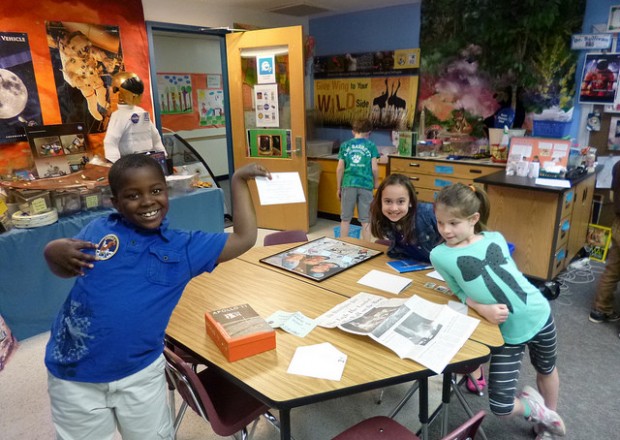Providing an environment that is safe, but that also allows for growth and independence, is a priority when teaching 2nd grade. It is a year when children are becoming comfortable in the school environment and really beginning to explore individuality, as well as relationships with their peers. Implementing the appropriate classroom management strategies will help create a learning environment that is both safe and successful.
-
Establish classroom policies immediately and enforce them consistently.
It is important to send the message from day one that there are expectations in the classroom and consequences for not following rules. Failing to establish the classroom policies on the first day opens up a window for bad habits to form. Teachers should introduce policies, procedures and discipline strategies, as well as any reward systems or positive reinforcement strategies put in place. This lets students know that there are expectations for being successful in the classroom, and they can decide early which path they plan to take.
Some teachers believe once the policies are laid out, there is no need to keep bringing them up. Wrong. Second grade students still need a great deal of reinforcement to be successful. They should be reminded every day (and even multiple times per day) of the classroom expectations. It’s not a terrible idea to have them write out the policies, and maybe even have them come up with some “rules” of their own for the classroom. This allows the students to feel like they are part of the learning community.
-
Develop classroom rules and consequences that are fair and logical.
It’s important for teachers to be realistic when setting expectations for 2nd graders. Although they are getting older and are able to focus and do more academically, they are still young children with short attention spans. Expectations should not exceed physical limitations. Teachers who make rules such as, “Nobody may talk for the entire free reading time” are setting themselves up for failure. A better option would be, “Talking during free reading time is distracting to others and may get you moved away from your classmates”.
Consequences, as well, need to be logical and directly connected to the rule that was broken. If a student makes a mess during art time, the student should have to miss something favorable to clean up the mess. However, just taking away a recess or keeping the child from doing another fun activity is arbitrary and will just begin a power struggle with the student. Much like parenting, teachers must choose their battles. Consequences for every little rule infraction will soon become ineffective.
-
Use positive rather than negative language.
Telling a 2nd grader NOT to do something will immediately cause the child to think of the exact thing they were told to avoid. Saying, “You better not think about writing on your hands with these markers” will probably result in a classroom full of inked up hands. Rather than telling students what NOT to do, teachers should word rules in a positive way. Here are some examples:
- “Don’t run in the halls” should be “Please walk in the halls”
- “Don’t talk when I’m talking” can be replaced with “Please listen to the teacher when she is talking”
- “Please shut the door quietly” can replace “Don’t slam the door”
Also, using the words “expectations” rather than “rules” and “consequences” instead of “punishments” sets a more positive tone in the classroom. Kids are inundated with rules and punishments in their lives, so just by using words with more positive connotations will help the teacher get more positive results.
-
Always be mindful of different learning paces and keep all students occupied.
Not all students work at the same pace. One mistake that teachers make with younger grades is expecting students to occupy themselves appropriately when they finish an assignment before others. 2nd graders are curious and social by nature, so when they are finished, they want to ask others around them questions, help others who aren’t finished, or just simply socialize. Teachers should always have an extension in place for those who finish early. A good idea is a “challenge level” assignment. This can be an extension of the original lesson that is a bit more challenging. This way, students can remain working and stay focused on the concept being taught.
There will also be students who are not quite grasping the lesson and become off task. Teachers should walk around and check on student progress, helping those who get stuck before they get a chance to become disruptive or too frustrated. 2nd grade students need to be monitored quite frequently when working.
-
Stay organized.
Teachers who stay one step ahead of students seem to have more success with classroom management. Being prepared for lag time or lessons that didn’t go as planned will help maintain structure in the classroom. One of the biggest mistakes teachers of young children make is giving “free time” with no structure. Even that needs to be organized. “Free time” should consist of a few different options for children, that have been thoroughly explained before they are set loose.
It’s very helpful to have the daily or weekly agenda up in the classroom for students to see. This way, they can always look on the board for a reminder if they forget what they should be doing. It also provides security, because they students know the day is planned out and they have goals to accomplish.
Establishing a structured learning environment early on and enforcing it regularly is one of the most effect ways to build confident and successful students. 2nd grade children need and appreciate boundaries. They feel safer when there are expectations clearly set out for them, and they can predict the consequences of their actions, both positive and negative. Developing effective classroom management strategies is one way 2nd grade teachers can ensure a successful outcome in any learning environment.
